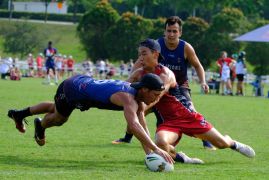Touch typhoon forming in the Philippines
14 Dec 2020 @ 9:45 UTC
Touch in the Philippines continues to weather the COVID-19 storm, but even the pandemic has failed to stymie the plans of Touch Association Pilipinas to make an impact at the next World Cup.
The first organized Touch competition in the Philippines was a female-only competition between three international schools which had adopted Touch as a school sport. From this small beginning, the sport has spread to some Universities and now there is a thriving club scene.
Women still dominate in terms of player numbers according to Rey Gigataras, president of Touch Association Pilipinas, “We have the unique situation where we actually have more female players compared to male players.” Rey related this fact in a recent ‘Set of Six’ episode with Adam Collins, from the Federation of International Touch (FIT), and they were joined by Martha Tan who is the Secretary General of Philippines Touch.
Pandemic lockdown
Rey spoke about the Covid-19 situation, stating that, “Here in the Philippines it’s pretty serious and it’s ongoing.” The pandemic peaked in August and the number of reported daily infections has been trending down, however, there were still 1,499 confirmed cases on December 11. Tragically there have been 447,000 positive cases and 8,709 deaths so far. Intermittent lockdowns have been put in place by the Government and organized sport is not allowed. Martha Tan said, “This has been a heavy blow for everybody,” although the Touch community has adapted and stayed connected through online yoga, fitness, and strength training.
Thriller in Manila
Touch in the Philippines, a South East Asian nation of 110 million people, is played in the metropolitan area of the capital city Manila, which is located on the island of Luzon. This is one of 7,641 islands that make up this archipelago nation which stretches 1,850 kilometres from north to south and 1,130 kilometres from west to east. This vast geographical spread is a real challenge in terms of exporting Touch to other parts of the country but according to Rey the Manila area, “Is a catchment of about 40 million.” There is huge potential for growth, therefore in the Metro- Manila area alone.
Hard work in the hiatus
Philippines Touch have used the pandemic induced hiatus to bring about an administrative reboot of the sport. “We are going through the growing pains of a very small club- based organization run by one or two people to try to run a national organization,” said Rey. There is a new board, and more people are coming forward to help and volunteer their time. Working groups have been established to improve the areas of business development, marketing, coaching, and refereeing.
Hopes of mixed success
The new Board have also arrived at a plan for on-field improvement once play can resume. It has been decided that the focus will be to improve the level of the Mixed Open team for World Cup 2023. As such John Beazley, from Australia, has been appointed as the Mixed Open coach as well as being appointed as national head coach, with a view to him becoming a mentor for the soon to be appointed Men’s Open and Women’s Open coaches. The Mixed Open team will be selected first from the elite player pool, followed by the Men’s Open and Women’s Open teams. The 2019 World Cup was a successful tournament for the Philippines. The Men’s Open team won five of seven pool matches and came sixth overall. The Women’s Open team had many close matches and learnt a lot from the experience. Martha Tan, who played in the Women’s Open team in Malaysia said “We can see there is so much we can cultivate and where we can improve. We have a way to go but we are getting there.”
Heritage balance
Another issue being looked at leading into the Asian Cup in 2021 is how to balance the selection of Philippines based players with overseas-based players of Filipino descent who wish to represent their country of origin. “We have a lot of heritage-based players, people who have migrated overseas from the Philippines who want to play,” said Rey. Many of these players live in Australia and play to a very high level. “It is a delicate balancing act between heritage players who want to play while making sure we develop our local athletes.” It is hoped that the administrative and coaching structure changes can help in raising the playing level of the local Philippines based players so that more of these players will represent their country at international competitions.
Passion and structure
Philippines Touch is hungry for more international competition and is urging FIT to hold the Asian Cup, not just next year but also in 2022 to allow for more international matches before the next World Cup. This hunger for improvement is being driven by a small band of volunteers whose passion and love for the sport is now matched by an organizational structure which will hold Philippines Touch in good stead for many years to come.

